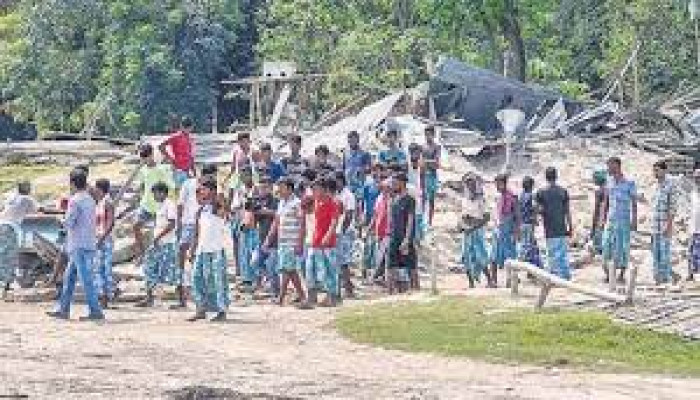How Serious is the Problem of Land Encroachment in Assam?
- In Politics
- 09:56 PM, Oct 09, 2021
- Ankita Dutta
The modus operandi of the infiltrators is to grab the land of the native residents of the area through means, fair or foul. In many instances, they also try to legally possess cultivable land. The process of completely evicting the illegal infiltrators from their lands is a tenuous one, for these are mostly Government lands or lands which have been procured through land mafias who force the owners of these lands to sell them at throwaway prices.
In the recent Gorukhuti incident, the police perhaps believed that the migrants would be deterred by the show of force and were therefore unprepared for the kind of mob reprisal which took place that day. There are contentions that had the district administration been better prepared they would have been able to avert the whole imbroglio. Several episodes in the socio-political history of Assam are proof enough of the fact that these encroachers are not the ones who would give up their landholdings so easily.
The State Government has announced the Gorukhuti Multipurpose Agricultural Project worth Rs. 9.60 crore in the 77,000 bighas of Government land, huge parts of which had been occupied by illegal infiltrators. The idea is to promote afforestation and agriculture activities by setting up collective farms of local Assamese youth in these lands. To execute the project, the land under occupation has been proposed to be taken over. The Government alone has the authority to acquire or take over possession of any land in case of requirement for any bona fide purpose.
These lands are mostly located in the riverine areas, prone to flooding and erosion. The people of Gorukhuti, comprising primarily of Assamese and Nepali Hindus, are mainly associated with dairy and agricultural farming related activities. In fact, till 1979, the plain areas of the Dholpur hills happened to be the farmlands of these people, and hundreds of them, including their families, operated their dairy farms. They made use of their earnings from their dairy farms to take care of the daily expenses of the Shiva Mandir. Hence, this area is also popularly known as Goru-Khuti, literally translated as ‘cow-farm’ in English.
The Gorukhuti Multipurpose Agricultural Project is an ambitious one, aimed at bringing in “modern farming techniques and scientific animal rearing practices” to Darrang district and elsewhere too, after turfing out a more than 7,000-strong farming community of Bengali-speaking Muslims. It also marks the beginning of the Assam Government’s plan to make the state self-sufficient in agriculture and allied sectors, besides generating income for the local youths. The aim is to establish a model farm and provide training to the youth, after which the Government mulls to create more such farms in other parts of the state. The project targets to clear around 10,000 bighas of land in two char areas of Gorukhuti, and then set up a model farm. On the request of the Agriculture Department, the district administration declared the area as “community agricultural land”.
The first step in this direction would be to evict the encroachers and protect the land from fresh encroachments. The training of youths for the project has already started and even young girls have come forward to get involved in it. The government is also planning to give them Rs. 6,000/- per month as remuneration, besides other facilities. Further, camps will be constructed for the new workers on the site of the project. They will be built at the same location where the razed houses of those evicted stood in the three villages of Dholpur, on the char (sand bars created by the shifting course of the river) which emerged out of the Brahmaputra some decades back. Initially, around 500 youths of the locality would be engaged. Later, depending upon the success of the project, around a thousand youths would get self-employment opportunities. The Government is also planning to constitute a farmers’ cooperative society with the help of the youths engaged in the farm.
Farming is already underway in around 40-50 bighas (roughly 15 acres of land). Vegetables like spinach, bottle gourd, and pumpkin are being cultivated. However, since this area is not suitable for the cultivation of kharif (summer) crops because of the annual rains, the Government is focusing more on winter (rabi) crops. Moreover, since the area gets submerged during the rainy days, elevated platforms will have to be constructed for cattle farming and piggeries. Fisheries will also be set up as a part of the project. The Government has already initiated steps to bring in at least 500 cows from Gujarat. Work on the construction of a temporary bridge to connect the char areas with the mainland has also begun, and it is likely to be completed soon. This bridge will help in reaching the char area without boats. A temporary road is being constructed too, so as to enable people to cross the Nanoi, a channel of the Brahmaputra, since the water levels are now receding post the monsoon floods.
The evicted Muslim families whose houses, mosques and schools were razed for the Gorukhuti project, now live across the Nanoi in shanty dwellings. Over the past several years, the char lands were completely out of the purview of the Government, for they were under illegal occupation. If the Gorukhuti Agricultural Project is successful, this is definitely going to usher in a new era of cultural change in the overall societal landscape of the Assamese society. It is because the successful implementation of such projects would also solve the problem of unemployment in the state to a great extent.
To make Assam agriculturally self-sufficient and also provide employment opportunities to our local youth, it is very important that the Government effectively utilises all the char lands for farming. But the youth will have to hang on despite all the difficulties posed by the yearly monsoon floods, far away from their friends and families. Even a short vacation of the site by people will again see the re-occupation of all the evicted lands by the encroachers. It would require persistency and patience on the part of our youth, who are often blamed to be a lazy lot as compared to the extremely hard-working Muslim migrants.
Land encroachment by illegal settlers has now become a question of existential survival for the common Assamese people. The Assam Movement (1979-85), the Brahma Committee Report on Land Rights, Upamanyu Hazarika’s one-man Commission on border-sealing, NRC, the anti-CAA movement and most recently, the Clause 6 recommendations of the Assam Accord (1985) – all had the immigration issue as a contributory factor at the very least. The Upamanyu Hazarika Commission Report even mentioned that illegal immigration from Bangladesh is threatening to reduce the indigenous population of Assam to a minority in their own homeland by the year 2047.
H.S. Brahma, who headed the Committee for the Protection of Land Rights of Indigenous People that was constituted by the Sarbananda Sonowal Government in 2016, had submitted a report to the Government of Assam which gave a detailed account of the problem of land encroachment in the state. In its report, the Committee made a series of recommendations on amending the land laws. It had estimated that 63 lakh bighas of Government land was under illegal occupation, an area twice the size of Goa!
Pallab Lochan Das, the revenue minister in the Assam Legislative Assembly in 2017, had replied that over 49 lakh bighas or 6,652 sq. km of land was under encroachment in Assam. This area would roughly account for twice the total area of Goa and just a little less than that of Sikkim. According to the Brahma Committee Report, the total area encroached upon includes 3,172 sq. km of forested lands, besides the large tracts of land belonging to the Vaishnavite Sattras and ancient Mandirs that have been encroached upon. It also mentioned that the people of Assam were facing a crisis of identity as their land was encroached upon by illegal infiltrators. The panel’s report said,
“…day in and day out, new areas are encroached upon by thousands of illegal Bangladeshis. Organised swarms of land-grabbing suspected Bangladeshis…equipped with construction materials and arms descend on vacant char areas (riverine islands) to establish illegal villages overnight and the efforts of the indigenous people to resist such organised invasions are met with counter-resistance and armed attacks.”
The report specifically observed, “In case no effective constitutional, legal and administrative steps including sealing of the India-Bangladesh border, and detection and deportation of the illegal infiltrators are taken, the indigenous people are bound to be reduced to a landless class of people and become foreigners in their own home.” The report further pointed out that all lands in the char areas of Assam are settled by a well-established institution known as Matabbar or Dewani. For all practical purposes, they play the role of the Government, dole out land and make allotments of land. They are landlords, with sprawling estates wielding tremendous political and financial clout, which dissuades others from raising a voice against them.
In order to inject a fear psychosis in the minds of the Muslim migrants, the Matabbar utilises their authority to threaten to get them detected or arrested by the police. Therefore, ignorance or the absence of Governmental control over these vast stretches of char lands provides a fertile ground for these players to carry on with their irregular and criminal activities. To control such mischief and manipulation, the Government needs to intervene strongly and effectively. These are enough evidences that lay bare the fact that the problem of encroachment of Government lands by infiltrators in Assam is real.
The social, political and economic lives of the people of the state have been affected in many different and complex ways because of such land grabbing. A nefarious agenda that swears by the liberal logic of tolerance and secularism is to be blamed for much of the problems that the state is facing today. It amounts to denigrating the genuine concerns of a community for basic survival against an ever-expanding religious cult. Politically motivated narratives such as religious intolerance, discrimination against Muslims, violation of human rights, etc. have been deliberately woven in order to camouflage the real problem that cannot be downplayed simply as a Hindu-Muslim concern. It has more to do with the land rights of the natives and the constant threat posed to their lives and livelihoods by the infiltrators.
Eviction drives in Assam have to be a continuous process, in the larger interest of freeing the local people’s lands and government lands, which have been forcefully occupied by the illegal Bangladeshis for several years now. At a time when the issue of migration has toppled governments and global political paradigms in the West, not anticipating a popular reaction from the common people of Assam where almost one-third of the population has become that of migrants is politically too naïve a supposition. There has been a disproportionate increase in the Muslim population of Assam over the past few decades. It’s high time that the problem is no longer weighed against the same set of “liberal” principles of freedom and secularism. It is all about self-preservation and protection of the culture of a community in the wake of a serious threat to their survival.
The anti-foreigner narrative can no longer be reduced to a mere political gimmick in which political parties of all shades are able to reap their maximum advantage. This therefore brings us to one of the most important questions – What can be a permanent and long-term solution to the problem of land encroachment by infiltrators in Assam? What needs to be accepted here is that over the years, the problem of encroachment of Government lands in several areas of Assam never fell in the Government’s priority list. Till date, a thorough survey of the people in districts like Dhubri, Barpeta, Goalpara, South Salmara-Mankachar, Nagaon, etc. who became landless due to Islamic demographic invasion has not been carried out.
This has only added weight to an already expanding problem since it leaves enough space for the encroachers to claim that they are erosion-hit people. One of the possible solutions to this problem can be that the State Government can carry out a thorough survey of all the landless people in the state and allot small plots to them. After this is done, there must be strict vigilance and no one should be allowed to encroach upon Government lands. It is seen that those evicted usually encroach upon lands elsewhere. E.g., the much-touted eviction drive in Kaziranga in 2016 is a very good example, because the evicted encroachers once again encroached upon the lands in the vicinity, making the entire process a farce.
Undoubtedly, such large-scale encroachment of Government lands including forest lands could not have been made possible without political patronage. The situation is dangerous all over the state, particularly in eight to ten districts of Lower Assam. As per the Census data of 2011, districts like Barpeta, Bongaigaon, Darrang, Dhubri, Goalpara, Hailakandi, Karimganj, Morigaon, and Nagaon, have been most seriously affected. These are also the districts which have contributed in a large measure, to the changing religious demographic pattern of Assam. The recent incident at Gorukhuti village under Sipajhar revenue circle in Darrang district of Lower Assam and the subsequent events that unfolded, have once again demonstrated that there is no alternative to a protective legislation for safeguarding the land and livelihood rights of the common Assamese people.
If a protective legislation reserving land for the native people is put in place, then those of Bangladeshi origin would no longer be able to acquire permanent rights over land. Detailed recommendations in this regard have been given by the Committee constituted under Clause 6 of the Assam Accord by the Central Government. It has recommended reservation of land, employment, and trade licenses based on an NRC that is carried out with 1951 as the base year. In the words of Upamanyu Hazarika, “Had such protective legislation been not in place, then CM Himanta Biswa Sarma could not have granted 6 bighas (1.5 acres) of land for those who had been evicted.” Encroachment is an offence under the Assam Land Grabbing Act, 2010, providing for a maximum punishment of 5 years. Over and above this, when encroachers attack police personnel undertaking eviction operations, it constitutes yet another offence.
Generally, it has been seen that the people who encroach upon Government lands claim that they were erosion-affected or their farm lands were destroyed due to siltation after the annual floods. In such cases, the administration can always take their details and cross-check the facts with the revenue officers of the respective places from where they initially came. This is normally not done as not many people are ready to take such pains to go through the rigorous process. It is precisely because of this reason that even persons who have land elsewhere manage to illegally grab Government land, claiming themselves to be landless.
Earlier, whenever any encroachment of Government land took place, the circle officers reported the matter to the sub-divisional officers who, in turn, informed the Deputy Commissioners to immediately pass an order for eviction. It was after the receipt of the eviction notice that the encroachers approached the Court, which monotonously delayed the entire process. But, after the amendment of the Land Revenue Regulation, the circle officers can evict the encroachers by giving them a notice of just one or two days. But such encroachment drives have been hardly launched.
Over the years, the district administration or forest officers, under whose jurisdiction the encroachments take place, are penalised. Hence, they prefer to look the other way when the encroachments begin. Later, it becomes extremely difficult to evict the encroachers. As reported in The Assam Tribune of September 27, 2021, the Assam State Electricity Board (now Assam Power Distribution Company Limited) has been responsible for giving power connections to the encroachers of Government lands in complete violation of the rules.
Several hill areas surrounding the city of Guwahati have also been encroached upon. Large-scale encroachment of these hills around Guwahati began only after the shifting of Assam’s capital from Shillong to Dispur. At that time, there was no housing project for Class III and Class IV employees. The prices of lands skyrocketed in the city after the shifting of the capital. Hence, they preferred to grab land on the hills, blessed by a politically influential network of land mafias and criminals. Gradually, people who flocked to the city in search of menial jobs, grabbed as much land as they could. The process continued in full steam as the Government also never bothered to take a serious note of the issue. Another interesting aspect is that most of the encroachers of the hills around Guwahati are not landless people since they already own land elsewhere in the state.
The need of the hour is a detailed study of the real, ground-level situation of the extent of encroachment so that eviction drives that are to be undertaken in the near future are focused on all those of dubious nationality, surviving on encroached lands. Compiling data for such a detailed study definitely cannot be completed overnight, but will require time and due diligence on the part of those entrusted with the task. Proper and timely implementation of the recommendations of the Committee for the Implementation of Clause 6 of the Assam Accord, and the HS Brahma Committee Report on the Protection of Land Rights of Indigenous People could have solved the problem of encroachment of Government land to a great extent.
It may be mentioned here that the Committee for the Implementation of Clause 6 of the Assam Accord, headed by Justice (Retd.) Biplab Sarma had recommended that an Act should be enacted in the Assam Legislative Assembly to make encroachment of Government lands including forest lands, a cognisable offence with provisions for an expeditious trial. But, the report, which was submitted in February last year, is yet to be implemented by the Central and the State Governments. The Committee, in its report, laid stress on the protection of the land rights of the indigenous people of the state, and also said that all wetlands, grazing reserves, etc. should be freed from encroachment and protected from further encroachment.
It specifically mentioned that the char areas should be surveyed and the newly created chars should be treated as Government land. The erosion-hit people should get priority in the process of land allotment in the char areas, while such land should also be utilised for agriculture and allied activities. Further, the Committee pointed out that land records in Assam are in a mess and the Government should undertake a time-bound programme for updating and authenticating the land records. For this, it suggested that a time-bound three-year plan should be chalked out to give land pattas to the indigenous people of the state. The land administration in the state also needs to be strengthened with immediate effect.
In this context, the Committee mentioned that the provisions of the Assam Land Revenue and Regulation should be strictly followed for imposing curbs on the transfer of land to non-indigenous people. It also said that the recommendations put forward by the HS Brahma Committee need to be strictly implemented. However, unfortunately, the Government is yet to take a decision on the implementation of the recommendations of the Committee. It is now time that bold steps are taken by the Government to evict encroachers of suspicious nationality from all over the state.
The citizenship of the evicted people must be thoroughly checked, re-checked and cross-verified before giving them land allotment elsewhere. It would also require extensive cooperation at all levels from the common citizens, to free all lands from the clutches of infiltrators. Unless these steps are taken by the administration, the future of Assam is too dark and dangerous. As CM Dr. Himanta Biswa Sarma has repeatedly said, it is a civilisational war that Assam is fighting on many fronts. The politically and monetarily influential forces who try to create a volatile situation in the name of ‘discrimination against Muslims’ every time an eviction drive takes place in Assam, must be strictly dealt with by the state.
Acknowledgement: A sincere note of thanks to S. Sarma Baruah for enlightening me on various minute aspects of the issue of land encroachment.
Image source: Hindustan Times
Disclaimer: The opinions expressed within this article are the personal opinions of the author. MyIndMakers is not responsible for the accuracy, completeness, suitability, or validity of any information on this article. All information is provided on an as-is basis. The information, facts or opinions appearing in the article do not reflect the views of MyindMakers and it does not assume any responsibility or liability for the same.







Comments